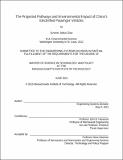| dc.contributor.advisor | John B. Heywood. | en_US |
| dc.contributor.author | Zhao, Summer Jiakun | en_US |
| dc.contributor.other | Massachusetts Institute of Technology. Technology and Policy Program. | en_US |
| dc.coverage.spatial | a-cc--- | en_US |
| dc.date.accessioned | 2015-09-17T17:44:15Z | |
| dc.date.available | 2015-09-17T17:44:15Z | |
| dc.date.copyright | 2015 | en_US |
| dc.date.issued | 2015 | en_US |
| dc.identifier.uri | http://hdl.handle.net/1721.1/98582 | |
| dc.description | Thesis: S.M. in Technology and Policy, Massachusetts Institute of Technology, Engineering Systems Division, Technology and Policy Program, 2015. | en_US |
| dc.description | This electronic version was submitted by the student author. The certified thesis is available in the Institute Archives and Special Collections. | en_US |
| dc.description | Cataloged from student-submitted PDF version of thesis. | en_US |
| dc.description | Includes bibliographical references (pages 97-101). | en_US |
| dc.description.abstract | As the world's largest market for car sales, China's rapidly rising number of light-duty vehicles (LDVs) on the road have resulted in serious problems such as increasing CO2 emissions, energy insecurity, and air pollution. The question I examine here is how electrified vehicles (EVs) can help reduce China's energy demand and greenhouse gas (GHG) emissions in the future, and EV includes hybrid electric vehicle (HEV), plug-in hybrid electric vehicle (PHEV), and battery electric vehicle (BEV). First, by building and using an Electricity Supply and Emissions Model (ESEM), I forecast the life-cycle GHG emissions intensity factors of the electric grid between now and 2050, proposing three scenarios that represent different levels of adoption of renewable generation by utilities. Then, by developing three EV penetration scenarios with other assumptions such as vehicles distance traveled and powertrain mix for a China FLEET model, I project the stock, energy demand, and life-cycle GHG emissions of the LDV fleet for each scenario until 2050. By comparing the results of these different scenarios, I demonstrate to what extent electrification can reduce the LDV fleet's energy demand and emissions impact. Results from this study show that there is a significant potential for electrification to reduce the automotive energy demand, oil dependence, and life-cycle GHG emissions of the LDV fleet, because EVs and especially BEVs are much more efficient than traditional gasoline vehicles. Compared to growing the renewable energy contribution to the electricity supply system, expanding EVs in the fleet can occur on a faster time scale, provided that they become more attractive relative to conventional gasoline vehicles; the greater potential for aggressive EV penetration to reach a significant percentage suggests that strong efforts of promoting EVs are likely needed to take advantage of their reduction opportunities. However, cleaning up the grid is important not only because it helps lower the emissions of aggressive EV expansion, but also because power generation accounts for the majority of China's total energy consumption and emissions. Results also show that, in order to help China reverse the rising trajectory of CO2 emissions by 2030, the aggressive EV scenario and the more-renewables electricity scenario will likely be needed, which could enable the LDV fleet to peak its emissions as early as 2033. | en_US |
| dc.description.statementofresponsibility | by Summer Jiakun Zhao. | en_US |
| dc.format.extent | 103 pages | en_US |
| dc.language.iso | eng | en_US |
| dc.publisher | Massachusetts Institute of Technology | en_US |
| dc.rights | M.I.T. theses are protected by copyright. They may be viewed from this source for any purpose, but reproduction or distribution in any format is prohibited without written permission. See provided URL for inquiries about permission. | en_US |
| dc.rights.uri | http://dspace.mit.edu/handle/1721.1/7582 | en_US |
| dc.subject | Engineering Systems Division. | en_US |
| dc.subject | Technology and Policy Program. | en_US |
| dc.title | The projected pathways and environmental impact of China's electrified passenger vehicles | en_US |
| dc.type | Thesis | en_US |
| dc.description.degree | S.M. in Technology and Policy | en_US |
| dc.contributor.department | Massachusetts Institute of Technology. Engineering Systems Division | |
| dc.contributor.department | Technology and Policy Program | |
| dc.identifier.oclc | 921140718 | en_US |
